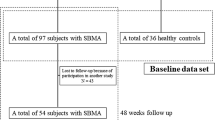Abstract
Oculopharyngeal muscular dystrophy (OPMD) is a progressive skeletal muscle dystrophy characterized by ptosis, dysphagia, and upper and lower extremity weakness. We examined eight genetically confirmed OPMD patients to detect a MRI pattern and correlate muscle involvement, with validated clinical evaluation methods. Physical assessment was performed using the Motor Function Measurement (MFM) scale. We imaged the lower extremities on a 1.5 T scanner. Fatty replacement was graded on a 4-point visual scale. We found prominent affection of the adductor and hamstring muscles in the thigh, and soleus and gastrocnemius muscles in the lower leg. The MFM assessment showed relative mild clinical impairment, mostly affecting standing and transfers, while distal motor capacity was hardly affected. We observed a high (negative) correlation between the validated clinical scores and our visual imaging scores suggesting that quantitative and more objective muscle MRI might serve as outcome measure for clinical trials in muscular dystrophies.



Similar content being viewed by others
References
Semmler A, Kress W, Vielhaber S, Schröder R, Kornblum C (2007) Variability of the recessive oculopharyngeal muscular dystrophy phenotype. Muscle Nerve 35(5):681–684
Fan X, Rouleau GA (2003) Progress in understanding the pathogenesis of oculopharyngeal muscular dystrophy. Can J Neurol Sci 30(1):8–14
Barbeau A (1969) Oculopharyngeal muscular dystrophy in French Canada (abstract of the presidential address). In: Brunette JR, Barbeau A (eds) Progress in neuro-ophthalmology Vol. 2. Excerpta Medica, Amsterdam, p 3
Fardeau M, Tomé FM (1997) Oculopharyngeal muscular dystrophy in France. Neuromuscul Disord 7:S30–S33
Brais B, Bouchard JP, Xie YG, Rochefort DL, Chrétien N, Tomé FM, Lafrenière RG, Rommens JM, Uyama E, Nohira O, Blumen S, Korczyn AD, Heutink P, Mathieu J, Duranceau A, Codère F, Fardeau M, Rouleau GA, Korcyn AD (1998) Short GCG expansions in the PABP2 gene cause oculopharyngeal muscular dystrophy. Nat Genet 18(2):164–167
Sieb JP, Schrank B (2009) Occulopharyngeal muscle dystrophy (in German). In: Sieb JP, Schrank B (eds) Neuromuscular disorders (in German). Kohlhammer, Stuttgart, pp 103–105
Tomé FM, Chateau D, Helbling-Leclerc A, Fardeau M (1997) Morphological changes in muscle fibers in oculopharyngeal muscular dystrophy. Neuromuscul Disord 7:S63–S69
Brais B, Xie Y, Sanson M, Morgan K, Weissenbach J, Korczyn AD, Blumen SC, Fardeau M, Tome FMS, Bouchard J, Rouleau GA (1995) The oculopharyngeal muscular dystrophy locus maps to the region of the cardiac alpha and beta myosin heavy chain genes on chromosome 14q11.2–q13. Hum Mol Genet 4(3):429
Brais B, Rouleau GA, Bouchard JP, Fardeau M, Tomé FM (1999) Oculopharyngeal muscular dystrophy. Semin Neurol 19(1):59–66
Mercuri E, Clements E, Offiah A, Pichiecchio A, Vasco G, Bianco F, Berardinelli A, Manzur A, Pane M, Messina S, Gualandi F, Ricci E, Rutherford M, Muntoni F (2010) Muscle magnetic resonance imaging involvement in muscular dystrophies with rigidity of the spine. Ann Neurol 67(2):201–208
Wattjes MP, Kley RA, Fischer D (2010) Neuromuscular imaging in inherited muscle diseases. Eur Radiol 20(10):2447–2460
King MK, Lee RR, Davis LE (2005) Magnetic resonance imaging and computed tomography of skeletal muscles in oculopharyngeal muscular dystrophy. J Clin Neuromuscul Dis 6(3):103–108
Bilgen C, Bilgen IG, Sener RN (2001) Oculopharyngeal muscular dystrophy: clinical and CT findings. Comput Med Imaging Graph 25(6):527–529
Bérard C, Payan C, Hodgkinson I, Fermanian J, MFMCS Group (2005) A motor function measure for neuromuscular diseases. Construction and validation study. Neuromuscul Disord 15(7):463–470
Mercuri E, Bushby K, Ricci E, Birchall D, Pane M, Kinali M, Allsop J, Nigro V, Sáenz A, Nascimbeni A, Fulizio L, Angelini C, Muntoni F (2005) Muscle MRI findings in patients with limb girdle muscular dystrophy with calpain 3 deficiency (LGMD2A) and early contractures. Neuromuscul Disord 15(2):164–171
Kornblum C, Lutterbey G, Bogdanow M, Kesper K, Schild H, Schröder R, Wattjes MP (2006) Distinct neuromuscular phenotypes in myotonic dystrophy types 1 and 2: a whole body highfield MRI study. J Neurol 253(6):753–761
Kesper K, Kornblum C, Reimann J, Lutterbey G, Schröder R, Wattjes MP (2009) Pattern of skeletal muscle involvement in primary dysferlinopathies: a whole-body 3.0-T magnetic resonance imaging study. Acta Neurol Scand 120(2):111–118
Fischer D, Kley RA, Strach K, Meyer C, Sommer T, Eger K, Rolfs A, Meyer W, Pou A, Pradas J, Heyer CM, Grossmann A, Huebner A, Kress W, Reimann J, Schröder RJ, Eymard B, Fardeau M, Udd B, Goldfarb L, Vorgerd M, Olivé M (2008) Distinct muscle imaging patterns in myofibrillar myopathies. Neurology 71(10):758–765
Fischer D, Walter MC, Kesper K, Petersen JA, Aurino S, Nigro V, Kubisch C, Meindl T, Lochmüller H, Wilhelm K, Urbach H, Schröder R (2005) Diagnostic value of muscle MRI in differentiating LGMD2I from other LGMDs. J Neurol 252(5):538–547
Kornblum C, Lutterbey GG, Czermin B, Reimann J, von Kleist-Retzow JC, Jurkat-Rott K, Wattjes MP (2010) Whole-body high-field MRI shows no skeletal muscle degeneration in young patients with recessive myotonia congenita. Acta Neurol Scand 121(2):131–135
Goutallier D, Postel JM, Bernageau J, Lavau L, Voisin MC (1994) Fatty muscle degeneration in cuff ruptures. Pre- and postoperative evaluation by CT scan. Clin Orthop Relat Res 304:78–83
Acknowledgments
The authors thank all patients for their willingness to participate in this study. We also would like to thank the reviewers for their helpful contributions that greatly improved the manuscript. D.F. is supported by a grant from the Lorenzo-Piaggio-Foundation, Switzerland. M.G. is supported by the Swiss National Science Foundation, Grant 325230-118377.
Conflict of interest
None.
Author information
Authors and Affiliations
Corresponding author
Additional information
Arne Fischmann and Monika Gloor authors are contributed equally to this work.
Electronic supplementary material
Below is the link to the electronic supplementary material.
Rights and permissions
About this article
Cite this article
Fischmann, A., Gloor, M., Fasler, S. et al. Muscular involvement assessed by MRI correlates to motor function measurement values in oculopharyngeal muscular dystrophy. J Neurol 258, 1333–1340 (2011). https://doi.org/10.1007/s00415-011-5937-9
Received:
Revised:
Accepted:
Published:
Issue Date:
DOI: https://doi.org/10.1007/s00415-011-5937-9




